This tutorial demonstrates how to import an existing FE model, apply boundary conditions, and perform a modal frequency response analysis on a flat plate. The flat plate is subjected to a frequency varying unit load excitation using the modal method. Post-processing tools will be used in HyperView and HyperGraph to visualize deformations, mode shape response, and frequency-phase output characteristics.
The following exercises are included:
| • | Setting up the problem in HyperMesh |
| • | Review the results (HyperMesh and HyperGraph) |
The following file found in the optistruct.zip file is needed to perform this tutorial. Refer to Accessing the Model Files.
modal_response_flat_plate_input.fem
|
Original ASCII OptiStruct input deck.
|
Exercise
Step 1: Launch HyperMesh and set the OptiStruct User Profile
| 1. | Launch HyperMesh. A User Profiles dialog appears. |
| 2. | Select OptiStruct and click OK. This loads the user profile. It includes the appropriate template, macro menu, and import reader, paring down the functionality of HyperMesh to what is relevant for generating models for OptiStruct. |
Step 2: Import the Finite Element Model File
| 1. | Click File > Import > Solver Deck. An Import tab is added to your tab menu. |
| 2. | Click the Open file icon  in the File: field. A Select OptiStruct File file browser window opens. in the File: field. A Select OptiStruct File file browser window opens. |
| 3. | Select the modal_response_flat_plate_input.fem file you saved to your working directory from the optistruct.zip file and click Open. Refer to Accessing the Model Files. |
The location of the file displays in the File: field.
| 4. | Click Import to import the model file. |
| 5. | Click Close to close the Import tab. |
Setting up the Problem in HyperMesh (Steps 3 - 12)
Step 3: Apply Loads and Boundary Conditions to the Model
In the following steps, the model is constrained at one edge. A unit vertical load is applied acting upwards in the positive z-direction at a point on a free edge corner of the plate.
First, the two load collectors (spcs and unit-load) are created.
| 1. | In the Model browser, right-click and select Create > Load Collector. |
| 3. | Click Color and select a color from the color palette. |
| 4. | For Card Image, set to None. A new load collector, spcs is created. |
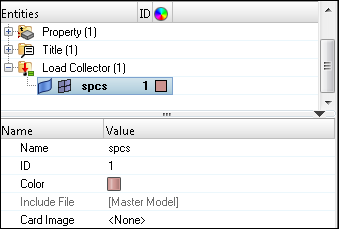
| 5. | In the Model browser, right-click and select Create > Load Collector. |
| 6. | For Name, enter unit-load. |
| 7. | Click Color and select a color from the color palette. A new load collector, unit-load is created. |
| 8. | Click the Display Numbers icon  to open the Numbers panel. to open the Numbers panel. |
| 9. | Click nodes > displayed. |
| 10. | Check the box next to display. |
| 11. | Select the green on button. All of the node numbers on the flat plate should now be displayed. |
Step 4: Create Constraints
| 1. | In the Model browser, right-click the load collector spcs and select Make Current. |
| 2. | Click BCs > Create > Constraints to open the Constraints panel. |
| 3. | Click the entity selection switch and select nodes from the pop-up menu. |
| 4. | Click nodes and select nodes 5, 29, 30, 31 and 32 (see figure). |
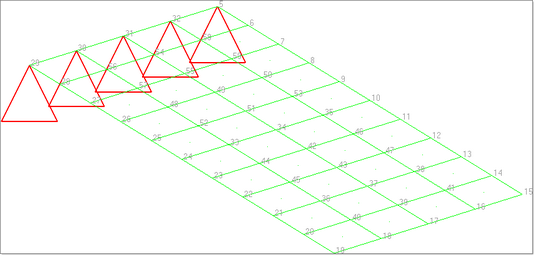
Illustration of which nodes to select for applying single point constraints
| 5. | Constrain dof1, dof2, dof3, dof4, and dof5. |
DOFs with a check will be constrained while dofs without a check will be free.
DOFs 1, 2, and 3 are x, y, and z translation degrees of freedom.
DOFs 4, 5, and 6 are x, y, and z rotational degrees of freedom.
You will need only to un-check dof6.
| 6. | Click create. The selected nodes will be free to rotate about the z-axis since dof6 was not checked. |
| 7. | Click return to return to the main menu. |
Step 5: Create a Unit Load at a Point on the Flat Plate
| 1. | In the Model browser, right-click unit-load and select Make Current. |
| 2. | Click BCs > Create > Constraints to open the Constraints panel. |
| 3. | Select node number 19 on the plate by clicking on it. (see figure). |
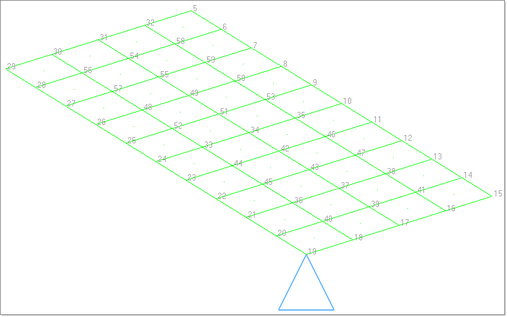
Node selected for creating unit vertical load.
| 4. | Uncheck all dofs except dof3, and click the = to the right of dof3 and enter a value of 1. |
| 5. | For load types =, select DAREA from the extended entity selection menu. |
| 6. | Click create. This applies a unit load to the selected node. |
Step 6: Create a Frequency Range Table
| 1. | In the Model browser, right-click and select Create > Load Collector. |
| 2. | For Name, enter tabled1. |
| 3. | Click Color and select a color from the color palette. |
| 4. | For Card Image, select TABLED1 from the drop-down menu. |
| 5. | For TABLED1_NUM, enter a value of 2 and press enter. |
| 6. | Click  below TABLED1_NUM and enter x(1) = 0.0, y(1) = 1.0, x(2) = 1000.0 and y(2) = 1.0 in the pop-out window. below TABLED1_NUM and enter x(1) = 0.0, y(1) = 1.0, x(2) = 1000.0 and y(2) = 1.0 in the pop-out window. |
| 7. | Click Close. This gives a frequency range of 0.0 to 1000.0 with a constant 1.0 over this range. |
Step 7: Create a Frequency Dependent Dynamic Load
| 1. | In the Model browser, right-click and select Create > Load Collector. |
| 2. | For Name, enter rload2. |
| 3. | Click Color and select a color from the color palette. |
| 4. | For Card Image, select RLOAD2 from the drop-down list. |
| 5. | For EXCITEID, click Unspecified > Loadcol. |
| 6. | In the Select Loadcol dialog, select unit-load from the list of load collectors and click OK to complete the selection. |
| 7. | Similarly select the tabled1 load collector for the TB field. |
The type of excitation can be an applied load (force or moment), an enforced displacement, velocity, or acceleration. The field TYPE in the RLOAD2 card image defines the type of load. The type is set to applied load by default.
Step 8: Create a Set of Frequencies to be used in the Response Solution
| 1. | In the Model browser, right-click and select Create > Load Collector. |
| 3. | Click Color and select a color from the color palette. |
| 4. | For Card Image, select FREQi from the drop-down menu. |
| 5. | Check the FREQ1 option and enter 1 in the NUMBER_OF_FREQ1 field. |
| 6. | Click  and enter F1= 20.0, DF = 20.0, NDF = 49, in the pop-out window. and enter F1= 20.0, DF = 20.0, NDF = 49, in the pop-out window. |
| 7. | Click Close. This gives a set of frequencies beginning with 20.0, incremented by 20.0 and 49 frequencies increments. |
Step 9: Create the modal method for eigenvalue analysis using the Lanczos method and specify the frequency range for eigenvalue extraction
| 1. | In the Model browser, right-click and select Create > Load Collector. |
| 3. | Click Color and select a color from the color palette. |
| 4. | For Card Image, select EIGRL. |
| 5. | Click V1 and enter a value 0.0, then click V2 and enter a value of 1000.0. |
This specifies a range of frequency between 0 Hz and 1000 Hz for eigenvalue extraction using the Lanczos method.
Step 10: Create an OptiStruct Loadstep
| 1. | In the Model browser, right-click and select Create > Load Step. |
| 2. | For Name, enter subcase1. |
| 3. | For Analysis type, select Freq.resp (modal) from the drop-down menu. |
| 4. | For METHOD(STRUCT), select Unspecified > Loadcol. |
| 5. | From the Select Loadcol dialog, select eigrl. |
| 6. | For SPC, select Unspecified > Loadcol. |
| 7. | From the Select Loadcol dialog, select spcs. |
| 8. | For DLOAD, select Unspecified > Loadcol. |
| 9. | From the Select Loadcol dialog, select rload2. |
| 10. | For FREQ, select Unspecified > Loadcol. |
| 11. | From the Select Loadcol dialog, select freq1. |
An OptiStruct subcase is created which references the constraints in the load collector spc, the unit load in the load collector rload2 with a set of frequencies defined in load collector freq1 and modal method defined in the load collector eigrl.
Step 11: Create a set of nodes for output of results
| 1. | In the Model browser, right-click and select Create > Set. |
| 3. | For Card Image, select None from the drop-down menu. |
| 4. | Leave the Set Type switch set to non-ordered type. |
| 5. | For Entity IDs, select Nodes from the selection switch. |
| 6. | Click on the yellow Nodes button and select nodes with IDs 15, 17 and 19. |
Step 12: Create a set of outputs and mass factors specific to frequency response analysis
| 1. | Click Setup > Create > Control Cards to open the Control Cards panel. |
| 2. | Select GLOBAL_OUTPUT_REQUEST and check the box next to DISPLACEMENT |
| 3. | Click the field box FORM(1) and select PHASE from the pop-up menu. |
| 4. | Click the field box OPTION(1) and select SID from the pop-up menu. A new field appears in yellow. |
| 5. | Double-click the yellow SID box and select SETA from the pop-up selection on the bottom left corner. |
A value of 1 now appears below the SID field box. This sets the output for only the nodes in set 1.
| 6. | Click return to exit the GLOBAL_OUTPUT_REQUEST menu. |
| 7. | Click next and select PARAM subpanel. |
| 8. | Scroll down the list using the arrow in the left corner and check the box next to COUPMASS. A new PARAM card appears in the work area screen. |
| 9. | Below COUPM_V1 click NO and select YES from the pop-up menu selection. Selecting YES uses the coupled mass matrix approach for eigenvalue analysis. |
| 10. | Check the box next to G. A new window appears in the work area screen. |
| 11. | Click below G_V1, and input a value of 0.06 into the field box. This value specifies a uniform structural damping coefficient and is obtained by multiplying the critical damping [C/C0] ratio by 2.0. |
| 12. | Scroll down using the arrow to the left corner and check the box next to WTMASS. A new window appears in the work area screen. |
| 13. | Click below WTM_V1, and input a value of 0.00259 into the field box. Three PARAM statements now appear in the pop-up menu on the work screen. |
| 14. | Click return to exit the PARAM menu. |
| 15. | Select the OUTPUT card. A new window appears in the work area. |
| 16. | Enter 3 in the number_of_outputs field. |
| 17. | Set the first KEYWORD to HGFREQ. Using HGFREQ results in a frequency output presentation for HyperGraph. |
| 18. | Set the second KEYWORD to OPTI. |
| 19. | Set the third KEYWORD to H3D. |
| 20. | Double-click on the box beneath FREQ and select ALL from the pop-up selection for all keywords. Choosing ALL will output all optimization iterations. |
| 21. | Click return to exit OUTPUT. |
| 22. | Click return to exit the Control Cards menu. |
Submitting the Job
Step 13: Submit the Job
| 1. | From the Analysis panel, select OptiStruct. |
| 2. | Following the input file: field text box and click save as. |
| 3. | Select the directory where you would like to write the OptiStruct model file, enter the name flat_plate_modal_response.fem in the File name: field, and click Save. |
| 4. | Select run options: switch and select analysis. |
| 5. | Click OptiStruct. This launches the OptiStruct job. |
If the job is successful, new results files can be seen in the directory where the OptiStruct model file was written. The flat_plate_modal_response.out file is a good place to look for error messages that will help to debug the input deck if any errors are present.
The default files written to the directory are:
flat_plate_modal_response.html
|
HTML report of the analysis, giving a summary of the problem formulation and the analysis results.
|
flat_plate_modal_response.out
|
OptiStruct output file containing specific information on the file setup, the setup of your optimization problem, estimates for the amount of RAM and disk space required for the run, information for all optimization iterations, and compute time information. Review this file for warnings and errors.
|
flat_plate_modal_response.h3d
|
HyperView binary results file.
|
flat_plate_modal_response.stat
|
Summary of analysis process, providing CPU information for each step during analysis process.
|
Review the Results (HyperMesh and HyperGraph)
Step 14: Review the results
This step describes how to view displacement results (.mvw file) in HyperGraph and also how to understand the displacement output (.disp file) from this run. The HyperView results file (.h3d) contains only the displacement results for the three nodes specified in the node set output.
| 1. | When the analysis process completes, click HyperView to open a HyperView session. |
| 2. | Close the Message log menu, if one appears. |
| 3. | In the HyperView window, click File > Open > Session. An Open Session File window opens. |
| 4. | Select the directory where the job was run and select file flat_plate_modal_response_freq.mvw. |
| 6. | A discard warning appears. Click Yes. |
Two graphs per page and a total of three pages are displayed in HyperGraph. The graph title shows Subcase 1 (subcase 1) - Displacement of grid 15 on page 1.
| 7. | Click the Axis toolbar icon  . Select Logarithmic option and use the parameters shown below (see figure) to make logarithmic plots of the results. . Select Logarithmic option and use the parameters shown below (see figure) to make logarithmic plots of the results. |

There are two sets of results on this page. The top graph shows Phase Angle verses Frequency (log). The bottom graph shows Magnitude verses Frequency (log) (see figure) for Displacement of grid 15.
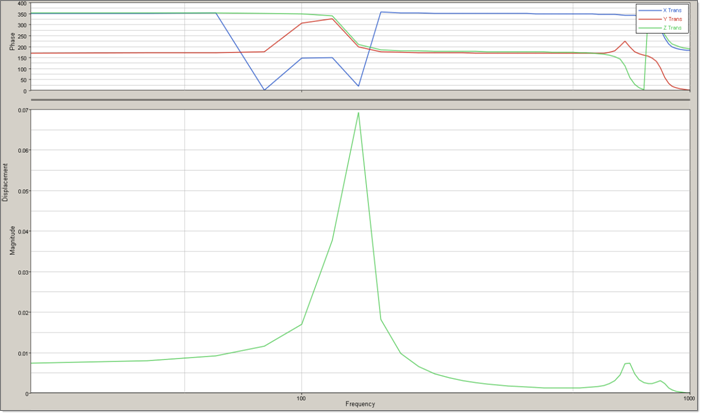
Frequency response of node 15
| 8. | Directly underneath the blue graph border, click the Next Page icon  . Page 2 displays, which shows Subcase 1 (subcase1) - Displacement of grid 17. . Page 2 displays, which shows Subcase 1 (subcase1) - Displacement of grid 17. |
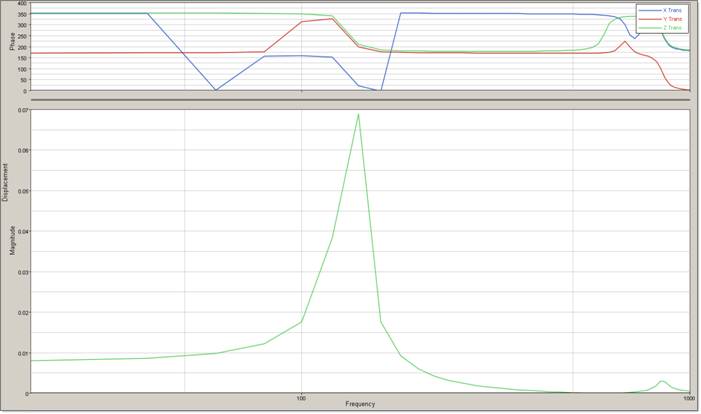
Frequency response of node 17
| 9. | Click the Next Page icon  again to display page 3 containing Subcase 1 (subcase1) - Displacement of grid 19. again to display page 3 containing Subcase 1 (subcase1) - Displacement of grid 19. |
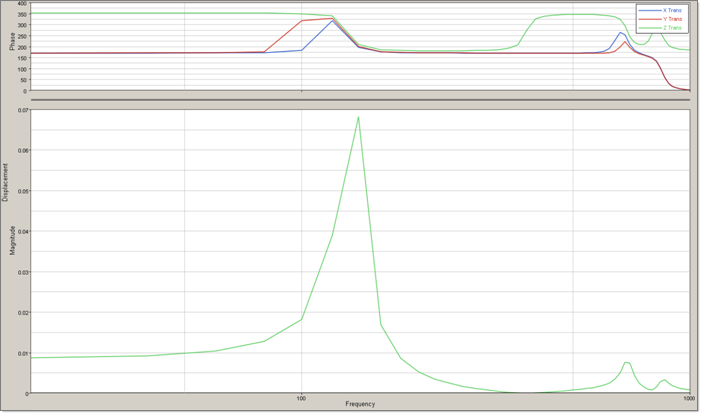
Frequency response of node 19
This concludes the HyperGraph results processing.
| 10. | Open the displacement file (.disp) using a text editor. |
The first field on the second line shows the iteration number, the second field shows number of data points, and the third field shows iteration frequency.
Line 3, first field shows node number, then x, y and z displacement magnitudes and x, y and z rotation magnitudes.
Line 4, first field shows node number, then x, y and z displacement phase angles and x, y and z rotation phase angles.
See Also:
OptiStruct Tutorials















